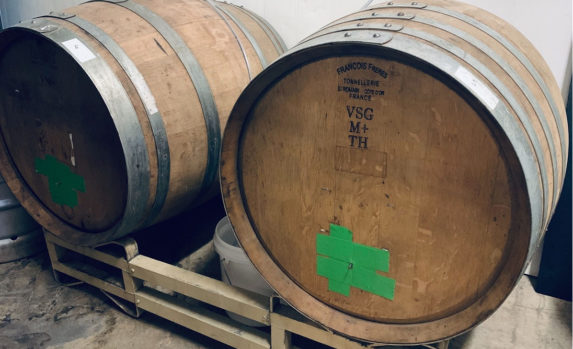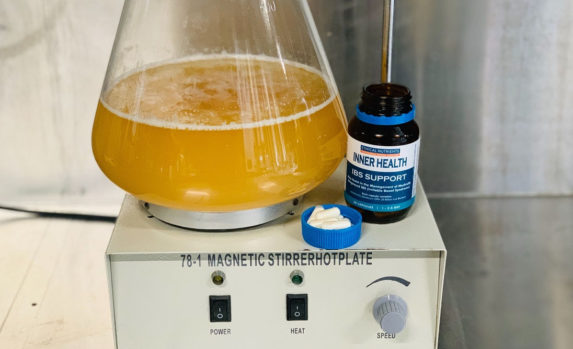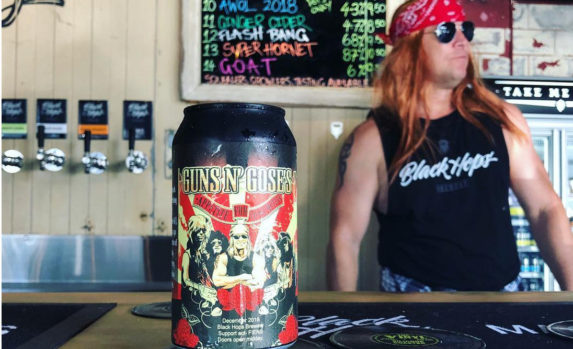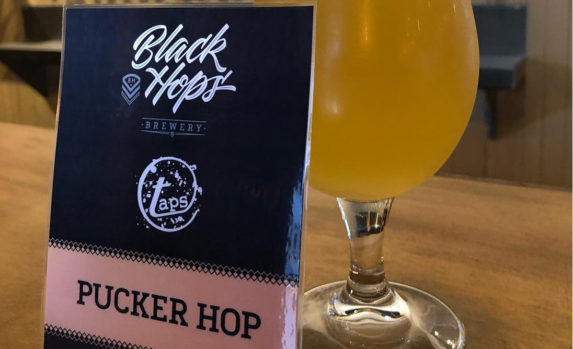Although they’ve been around for centuries, one of the newer (and very different) styles of beer currently gaining popularity among Australian craft beer drinkers are what’s known as Sours. As the name implies, these beers are brewed intentionally acidic, tart or sour due to the use of wild yeast and/or bacteria strains. Some Sour styles, such as Gose are also characterised by an additional salty flavour.
Sour beers vary wildly in flavour and intensity. Bacteria and wild yeasts would normally be a no-no in traditional brewing processes. But don’t be afraid, in the hands of a good brewer they’re cultivated and put to good use. Here at Black Hops we’ve been selectively releasing limited run batches of Sour beers since very early on..
Why do Sour Beers taste sour?
So what makes sour beers taste sour? Well, it’s all to do with the acidity level in the beer. This acid can be produced from bacteria such as Lactobacillus and Pediococcus, which as part of the brewing process create lactic acid and acetic acid (vinegar) following fermentation. Using wild yeast or performing chemical acidification or other methods of acidifying beer. The regulated presence of these acids in the brewing process is what gives these beers their ‘sour’ flavour. We go into our specific brewing process for Sour beers a little further on..
Types of Sour Beers
Sour beers are characterized by a range of different styles and brewing techniques. Some, such as those brewed in specific regions of Belgium, have been around for centuries.
Here’s a brief rundown on some of the most well known sour beer styles..
Gose (pronounced Gose-Uh): a top fermenting beer which originated in Germany, which, in addition to its sourness is characteristized by the use of salt and to provide its distinctive flavour.
Berliner Weisse: a tarty, cloudy German beer, typically around 3% abv and often served with a fruity syrup. It’s a good entry level point into the world of Sours.
Flanders Red Ale: sometimes referred to as ‘Flemish reds’, these Belgian beers with a distinctive red hue are fermented with brewers yeast and aged in oak barrels until mature.
Oud Bruin: another Belgian beer (originating in the Flemmish region), which is infused with cultured yeasts and is similar to Flanders Red Ale but is darker in colour, with brown ale used as its ‘base’ beer.
Lambic: these barrel aged Belgian beers are spontaneously fermented using naturally occurring wild yeast. Derivatives include Gueze, Kriek and Framboise.
American Wild Ale: US sour beers typified by the unusual strains of bacteria and yeast used to brew them.
How we brew Sour beers at Black Hops
Due to the challenges and complexities of brewing this style of beer, not all breweries are willing to include them in their beer repertoire. We’ve taken the leap, but it’s meant stepping out of our comfort zone and doubling down on our brewing and hygiene processes.
These beers aren’t the easiest ones to get right, and in many ways they go against everything taught from a traditional brewing perspective, which is focused on keeping bacteria and wild yeast out of the brewing process.
There’s two different ways you can brew a sour beer, which essentially comes down to a choice – metal vs wood.
Brewing a Kettle Sour (Metal)

We’ve mostly brewed Kettle Sour beers, mainly because we have a lot more control over the bacteria propagation process. It’s a more streamlined and safer way to brew a sour, as long as you have strong testing and hygiene practises in place.
Initially we follow the normal brewing process of mashing in the barley and wheat and running the wort off into the kettle. Then, instead of boiling it and adding hops, we bring it up to a temperature that will sterilize the wort. As an interesting side note, grains carry a lot of naturally occuring bacteria, so much so that you can use grain on its own as a sole source of souring beer (some brewers add a handful of grain in at the end of the brewing process to inoculate the beer) But by brewing like this you’re sacrificing control and repeatability, as you never know what cultures are on the grains.
From there we then cool it back down to 40 degrees in the kettle (by re-circulating it through the heat exchanger), a temperature that bacteria can both survive and thrive in. One challenge in this part of the process is that unwanted oxygen pick up can become a factor. As we discussed in our recent blog article, ‘Things to watch out for when canning beer’, introducing oxygen after the yeast have commenced active fermentation will cause the malt and hops in the beer to start going stale, just like it does to most food products. It may also cause the yeast to produce some unwanted off-flavours and aroma compounds. In the case of brewing Sours, lactobacillus combined with oxygen can produce unwanted funky aromas, often characterised as vinegary or tinny. To avoid this we seal up our kettle and blanket the wort with CO2.
Then we add our bacteria culture at 40 degrees (which we cultivate ourselves). We use lactobascillus plantarum, a well known strain of bacteria commonly found in fermented food such as sourdough bread, yoghurt, sauerkraut, kim chee, and certain cheeses. In this stage of the ‘souring’ process we aim to achieve a low PH level of mid to low 4’, which allows the lactobascillus plantarum to gain a good stronghold in the wort. We let the bacteria ferment between 24 to 48 hours, during which time we aim to get our PH level down to about 3.5, to give our beer the nice clean, sour base that we aspire to, without making it mouth puckeringly sour.
We then boil the wort again to kill off the bacteria and halt the souring process, then add the hops and transfer it from the wort into a fermenter. Typically the bacteria hasn’t had a chance to consume too much of the sugar, so there’s plenty left for the yeast to ferment and make alcohol. We then add whatever other ingredients will be going into the beer.
In the case of Frontyards, our first limited release sour beer of 2019, we split our sour base three ways (one of which became Frontyards) and added the different fruit and spice ingredients into each separate fermenter. This beer, with its cucumber and mint base, was a modern interpretation of the German Gose style beer, which also introduces salt into the mix. In our case we sourced our salt from seawater taken from the ocean right here at Burleigh! (measured and sterilized, of course) The salty/sour taste of Goses can accentuate the perceived sweet hues of the fruit.
The importance of hygiene
Another important aspect to cover off when brewing sour beers is to ensure that the bacteria you cultivate for sours doesn’t end up infiltrating the other beers you brew. So the importance of hygiene and ensuring that all of the brewing equipment and surrounding environment has been thoroughly cleaned and sterilised. The last thing we want if for residual sour beer bacteria to get into our next batch of Pale Ale.
The fact that the bacteria can become airborne and infiltrate little nooks and crannies of the brewery make this extremely challenging. To help us overcome this, we do an ATP (Adenosine Triphosphate) Test, which provides an indication of living cells present in the brewing environment. We clean the brewery inside and out and then perform the test to validate that it’s sterile. After cleaning the tanks we’ll swab the rinse water and the wort to determine if there are still any living bacteria or yeast present.
Brewing a Barrel Sour (Wood)

Barrel Sours are the original sour beers and follow a traditional brewing method of cultivating the bacteria needed for them in aged wooden barrels. The bacteria is allowed to run wild, cultivating its own unique and highly nuanced flavours. We’ve produced three such beers using the barrel souring method, a beer we’ve named AWOL (you can read the full description of it in our Black Hops sour beers list further below).
Brewing barrel sours involves a process of spontaneous fermentation that delivers minimal control over the types of bacteria used in the brewing process – typically the types of sour beers brewed in Belgium and the south of France. They don’t grow a culture and inoculate their wort, they have open fermenters which they fill up with hundreds of years worth of good micro-flora from their brewery (in the rafters above the tanks, for instance) and the surrounding environment. Open fermenters or coolships, which were traditionally used to cool wort before modern refrigeration or temperature control was available, are now starting to experience a renaissance amongst craft brewers. Typically they’re brewed in farming areas where wild yeast and bacteria thrive. We’d need to relocate our breweries to the country if we wanted to specialise in this type of brewing!
With our AWOL Sours, we created controlled conditions for spontaneous fermentation using wooden barrels as our inoculation point. We use whatever bacteria is present in the wood of the barrels to ‘sour’ our beers. Some of these barrels we’ve identified as being best for brewing sours, while others, for example whiskey barrels, are better for brewing stouts.
Every month we do sensory testing to try and achieve a degree of uniform flavour and consistency from what is a very uncontrolled and unregulated process (compared to brewing kettle sours.) It’s not too far removed from wine making in a sense. And sometimes you’ll need to be prepared to blend batches, or even dump a batch, as a result of the less controlled propagation environment.
Producing the right kind of ‘spontaneous’ bacteria for a good barrel sour can takes months to get right, but if you can manage it the rewards are great, with the amazing range of fermentation cultures taking these beers to the next level of flavour.
Due to the meticulous effort involved (and the larger risk of bacteria contamination), so far we’ve focused more on brewing the more regulated kettle sours. But in saying that, we’ve been very encouraged by the results of our three AWOL barrel sour beers, and plan to brew some more of these style of beers in the near future.
How we propagate our bacteria

We use lactobacillus plantarum capsules such as Inner Health Plus, which can be found in the fridge at pharmacies. We know these have been kept in a clean, regulated environment.
We use apple juice to grow our bacteria. Apple juice contains simple sugars for the culture to ferment that creates a similar growth media to MRS agar (a culture growth medium for Lactobacillus). Apple juice also contains B-Vitamins such as Thiamine which helps convert pyruvate into lactic acid and ethanol and Riboflavin which encourages growth.
And we use specific buffering salts and calciums to create the ideal environment for the bacteria to grow and to keep oxygen out. Calcium Carbonate provides enough buffering capacity to prevent the Lactobacillus from slowing their own growth via an over-acidification of their environment
We also use soda water as our pitching fluid. Soda Water repels oxygen, which prevents the creation of acetic acid (vinegar). The carbonation in the soda water also helps to keep oxygen away from the flasks when we start producing the culture.
We’ve perfected our process over the past 18 months and we’re now getting repeatable results from our bacteria propagation processes.
We only do them at HQ, not at BHII, as the risk of cross contamination within the much larger scale and size of BHII is too great . All your hoses, pumps, heat exchangers, the fermenter, canning machines and lines, even packaging processes, can all be contaminated with bacteria that is harmful to all the other beers we brew.
Our Sour Beers

Here’s the full range of Sours we’ve brewed over the past 18 months, from Goses and Berlinner Weisses through to our Barrel Sour Wild Ale series and a bunch of others.
Our first Sour was a Grapefruit Berlinner Weisse and our latest, which has just come out, is called RoséBerry Sour.
We’ve kept them as limited runs or as part of our Recon Series range, which we’ll continue to do in the foreseeable future.
Here’s a rundown on our Sour beer range to date, broken down onto their various styles..
Gose style beers
Frontyards: Made in our front yard, to be enjoyed in yours, our first limited release of 2019 was a modern interpretation of the classic German Gose style. With a saltiness achieved through the use of actual sea water from the beach out the front of Black Hops at North Burleigh (Frontyards), a lemon tartness of the Gose style and a refreshing mix of cucumber and mint, Frontyards is the ultimate summer smasher.
Guns ‘n’ Goses: This debut release by Black Hops’ top rock-dog Darren ‘The Gun Show’ Kearns’ to mark his first year of service, is a hard rocking interpretation of the classic German style Gose (pronounced ‘Goes-Uh’). With an amped up injection of hops to go with the rock solid Gose rhythm section of salty tartness, this beer seriously shreds and pummels. And at a breezy 3.9% it’ll bring some serious Slash to your smashing summer soundtrack. Welcome to the Jungle, baby!

Passionfruit & Vanilla Gose: this modern interpretation of a classic German style matches the lemon tartness of the lactic bacteria culture with a refreshing saltiness which was achieved through the addition of actual seawater from our very own front yard beach in Burleigh and split into 3 separate small batches, this batch is fermented with passionfruit and vanilla.
Berlinner Weisse Style Sours
Grapefruit Berliner Weisse: our very first Sour and brewed in the style of the renowned Berliner Weiss style sour.
Strawberry Berliner Weisse: As the prize for being crowned the Champion Brewer at this years Gold Coast Amateur Brewing Competition, home-brewer Andrew Mahony, was gifted a brew-day at Black Hops with our Brewmaster Govs. To show our shared support of Queensland’s strawberry farmers, a berry berliner weisse was selected as the style. Brewed with pale barley, wheat and lots of fresh strawberries and fermented with a blend of ale yeast and lactobacillus for a dry, tart finish – this beer offers a cooling refreshment of fruity flavours.
Barrel Sours
AWOL: This small batch wild ale is fermented with a symbiotic culture of bacteria and yeast and aged in an ex-Grenache oak barrel from South Australia. With added fresh passionfruit and mango, the balance of tartness and sweetness is pleasantly matched by the fruit and wood character. So far we’ve brewed subtle variations of this beer on three separate occasions (AWOL, AWOL 2018 and AWOL #3)
Other Sour beers we’ve brewed

Pucker Hop Sour IPA: Brewed in collaboration with our good friends at Taps Mooloolaba, this hoppy sour beer is refreshingly different. Cultured with a unique blend of saccharomyces cerevisiae, lactobacillus and brettanomyces for a depth of flavour and deliciously combined with floral and citrus hop aromas to enhance the mixed fermentation character. This light and tart IPA is very easy drinking.
Amaretto Sour: kettle soured amaretto sour, with the addition of fresh sour cherries and dissarano Amaretto.
Coffee Sour: Brewed in collaboration with our mates at Flutterbucks Pizza in Tyalgum NSW, using their freshly roasted Double Or Nothing Coffee. Taking a bold new approach to coffee beers, we have matched the light fruity notes of the coffee with a sour beer base to take your senses on a wild journey of aromas and flavours. Delicately sour with beautiful coffee aromas, this beer will keep you guessing.
RoséBerry Sour: We begin with a soft kettle-sour base, fermented with a symbiotic blend of our lactobacillus-plantarum culture and house ale yeast, then fruited with fresh raspberries, strawberries, sour cherries and cranberries and finally, spiced with french oak, rose hip and rose mallow. Unfiltered, refreshing and naturally wild, Roséberry Sour is a beer that wine drinkers and beer lovers can agree on.
